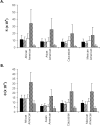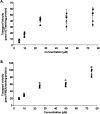The human multidrug resistance protein 4 (MRP4, ABCC4): functional analysis of a highly polymorphic gene
- PMID: 18364470
- PMCID: PMC2612728
- DOI: 10.1124/jpet.108.136523
The human multidrug resistance protein 4 (MRP4, ABCC4): functional analysis of a highly polymorphic gene
Abstract
ABCC4 encodes multidrug resistance protein 4 (MRP4), a member of the ATP-binding cassette family of membrane transporters involved in the efflux of endogenous and xenobiotic molecules. The aims of this study were to identify single nucleotide polymorphisms of ABCC4 and to functionally characterize selected nonsynonymous variants. Resequencing was performed in a large ethnically diverse population. Ten nonsynonymous variants were selected for analysis of transport function based on allele frequencies and evolutionary conservation. The reference and variant MRP4 cDNAs were constructed by site-directed mutagenesis and transiently transfected into human embryonic kidney cells (HEK 293T). The function of MRP4 variants was compared by measuring the intracellular accumulation of two antiviral agents, azidothymidine (AZT) and adefovir (PMEA). A total of 98 variants were identified in the coding and flanking intronic regions of ABCC4. Of these, 43 variants are in the coding region, and 22 are nonsynonymous. In a functional screen of ten variants, there was no evidence for a complete loss of function allele. However, two variants (G187W and G487E) showed a significantly reduced function compared to reference with both substrates, as evidenced by higher intracellular accumulation of AZT and PMEA compared to the reference MRP4 (43 and 69% increase in accumulation for G187W compared with the reference MRP4, with AZT and PMEA, respectively). The G187W variant also showed decreased expression following transient transfection of HEK 293T cells. Further studies are required to assess the clinical significance of this altered function and expression and to evaluate substrate specificity of this functional change.
Figures







References
-
- Adachi M, Sampath J, Lan LB, Sun D, Hargrove P, Flatley R, Tatum A, Edwards MZ, Wezeman M, Matherly L, Drake R, Schuetz J. Expression of MRP4 confers resistance to ganciclovir and compromises bystander cell killing. J Biol Chem. 2002;277:38998–39004. - PubMed
-
- Anderson PL, Lamba J, Aquilante CL, Schuetz E, Fletcher CV. Pharmacogenetic characteristics of indinavir, zidovudine, and lamivudine therapy in HIV-infected adults: a pilot study. J Acquir Immune Defic Syndr. 2006;42:441–449. - PubMed
-
- Belinsky MG, Guo P, Lee K, Zhou F, Kotova E, Grinberg A, Westphal H, Shchaveleva I, Klein-Szanto A, Gallo JM, Kruh GD. Multidrug resistance protein 4 protects bone marrow, thymus, spleen, and intestine from nucleotide analogue-induced damage. Cancer Res. 2007;67:262–268. - PubMed
-
- Chen ZS, Lee K, Walther S, Raftogianis RB, Kuwano M, Zeng H, Kruh GD. Analysis of methotrexate and folate transport by multidrug resistance protein 4 (ABCC4): MRP4 is a component of the methotrexate efflux system. Cancer Res. 2002;62:3144–3150. - PubMed
Publication types
MeSH terms
Substances
Grants and funding
LinkOut - more resources
Full Text Sources
Miscellaneous

